Some bonsai just command presence. Such is the case for a coast live oak, or Quercus agrifolia, donated by Al Nelson to the collections at the National Bonsai & Penjing Museum.
Nelson has become an expert in the care and training of coast live oak bonsai. He also has an oak at the Huntington Botanical Gardens in California.
Nelson was first introduced to bonsai in the late 1970s during his lunch hour one day while working as a salesman. John Naka was giving a demonstration at a California Bonsai Society event, and Nelson was immediately hooked. He already gardened in his spare time, so he bought Naka’s newly published book on bonsai techniques and taught himself.
“I attended various bonsai shows and took pictures of every single tree on black and white digital film, studied the photos and put them in a book,” Nelson said.
After getting some feedback on his bonsai, he decided to take a hands-on lesson. Nelson began studying under Harry Hirao in the early 1980s and eventually became Naka’s student – a fantastic partnership that would last about 20 years – and joined his study group Nam Pu Kai.
Nelson, Naka and Hirao spent many years collecting bonsai and scholar rocks together at Bixby Ranch in Santa Barbara County. There, Nelson fell in love with California oaks, which became his favorite specimen to work with and study. He has since collected hundreds of trees from the region.
“They’re such magnificent trees to me because they struggle to survive,” he said. “They get blown over and all contorted.”
The coast live oak at the Museum almost stayed hidden among the other gnarled branches and twisted trunks of Bixby Ranch. On one scouting expedition, Nelson spotted the tree, which was originally about 20 feet high with a beautiful base, but he decided digging it out would be too much work. After hunting around, he passed the tree again and gave in – he dug through rocky, tough soil for almost five hours to pull it from the ground.
Nelson cut off the tap root, which was one-and-a-half times the tree’s height. He covered its base with wet rags and moss because, he said, the tree thirsts for water without the tap root.
“The tree won’t get the water it needs, and you don’t want to dry it out,” Nelson said.
Nelson with the coast live oak in 2005 (left) and 2016 (right)
The oak didn’t have a leaf on it when he brought it home, but a few sprouted after a couple of months, so he drove the tree to Naka’s house to see if it had bonsai potential.
“John was really impressed,” Nelson said. “He said it was a magnificent tree and that one day it should be in the U.S. National Arboretum in D.C.”
Thirty years later, Naka’s proclamation came true. The oak has been housed in the North American Pavilion since 2016. Nelson has shown this oak at multiple demonstrations and, as the bonsai was 25 inches at the base at one point, Nelson had to lift it on and off tables with a hydraulic pump cart.
He said one of the most common accolades for his coast live oak is how many “fronts” it has – the oak doesn’t necessarily need to be positioned a certain way to look like an excellent bonsai. Instead of selling his beautiful specimen, Nelson gives his bonsai to mentees or established institutions like the Museum.
“I want my trees to have a good home because it’s not about the money,” he said. “Even my students have their names on copper tags on my trees for when I croak. But I wanted to see this one in the Museum, especially since Naka praised it so long ago.”
Former Curator Jack Sustic (left) with Nelson and the oak
Over the years Nelson has learned much about coast live oaks, like how they don’t grow well with wiring or that the branches grow down rather than out or up.
Museum Curator Michael James said staff have been caring for the tree based on Nelson’s recommendations. The bonsai is kept in the Museum’s temperate greenhouse during the winter to simulate its native climate.
The oak receives a high volume of water and Miracid fertilizer, and the tree is almost completely defoliated after a healthy flush grows out in the spring.
“We might leave some leaves in the inner portions in weak areas and at the base of shoots,” James said. “We cut all the elongated shoots off and anything that is too straight or is not going in the direction that we want.”
He added that the haphazard drooping and arching branches seen on wild oaks can look incredible and he is trying to maintain a “billowy” appearance when training the tree.
Nelson said he is thrilled that his oak at the Museum – his favorite bonsai – is looking strong.
“I’m so happy it’s getting some nice and tender loving care,” he said.


































